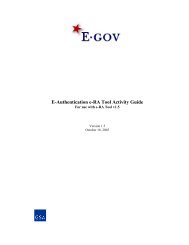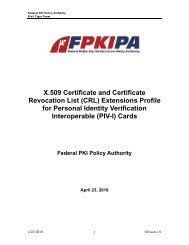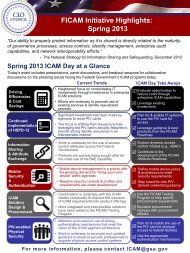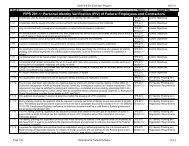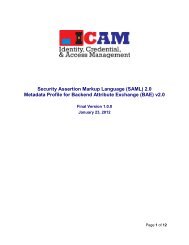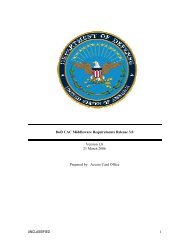CAC/PKI TRAINING GUIDE - IDManagement.gov
CAC/PKI TRAINING GUIDE - IDManagement.gov
CAC/PKI TRAINING GUIDE - IDManagement.gov
Create successful ePaper yourself
Turn your PDF publications into a flip-book with our unique Google optimized e-Paper software.
1 General<br />
4<br />
Product Manager<br />
Secure Electronic Transactions – Devices<br />
The Army Common Access Card (<strong>CAC</strong>)/Public Key Infrastructure (<strong>PKI</strong>) program implements<br />
Department of Defense (DoD) policy to adopt smart card technology department-wide. Smart<br />
card technology implementation has been led through guidance and direction of the Deputy<br />
Secretary of Defense and Public Law 106-65, National Defense Authorization Act for FY 2000.<br />
In response to these directives, the U.S. Army has aggressively pursued the programmatic steps<br />
required to ensure a seamless integration of this emerging technology at the operational level.<br />
The <strong>CAC</strong> will be implemented to provide the following functionality: personnel identification,<br />
building access, network access utilizing Public Key Infrastructure (<strong>PKI</strong>) certificates and<br />
eventually sending and receiving digitally signed and encrypted email. The <strong>CAC</strong> will replace<br />
the current Teslin military identification card (ID) and serve as the official ID card for civilians<br />
and eligible contractors. The <strong>CAC</strong> will also be used for physical access to facilities and serve as<br />
a token to enable logical access to networks and systems.<br />
The <strong>CAC</strong> will be issued using the existing Defense Enrollment Eligibility Reporting<br />
System/Real-time Automated Personnel Identification System (DEERS/RAPIDS) infrastructure.<br />
Approximately 1.4 million <strong>CAC</strong>s will be issued to all Army active duty military, National Guard<br />
members, select Reservists, DoD civilians and eligible contractors in FYs 01 to 02.<br />
2 Introduction<br />
On 6 May 1999, the Deputy Secretary of Defense issued a memorandum that encouraged<br />
widespread use of public key-enabled applications and provided specific guidelines for applying<br />
<strong>PKI</strong> services throughout the Department. The strategy to achieve the target DoD <strong>PKI</strong> is<br />
intrinsically linked to the overall DoD strategy for achieving information assurance (IA). The 12<br />
August 2000 Deputy Secretary of Defense memorandum further defines these guidelines and<br />
supercedes the memorandum of 6 May 1999. On 10 November 1999, the Deputy Secretary of<br />
Defense directed that the <strong>CAC</strong> be used as the DoD’s primary platform for the <strong>PKI</strong> authentication<br />
token. The report submitted in compliance with the requirement in Section 374 of FY 2000<br />
Defense Authorization Act (Public Law 106-65) requiring the evaluation of the option of using<br />
the smart card as the DoD’s authentication token concludes the smart card is the most feasible,<br />
cost effective technology for the authentication mechanism to support the DoD <strong>PKI</strong> and to<br />
protect its critical information.<br />
The DoD <strong>CAC</strong> will employ smart card and <strong>PKI</strong> technology. The <strong>CAC</strong> is the size of a credit card<br />
and contains an Integrated Circuit Chip (ICC) that is capable of storing a significant amount of<br />
data, has both read and write capabilities as well as a Personal Identification Number (PIN)<br />
selected by the cardholder. This PIN acts as a security code for the cardholder preventing others<br />
from fraudulently using the card. The <strong>CAC</strong> also contains a magnetic stripe, a Code 39 bar code,




